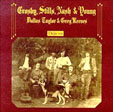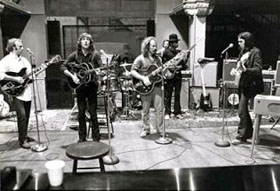
Deja Vu (1970)By all accounts, Deja Vu should have been a disaster. Already band members were holding onto their best songs for solo albums, the death of Crosby's girlfriend sent him into a debilitating depression, and Neil Young brought his brooding, languid style i The Songs. A close listen to Carry On and you can't help but be stirred by the multi-tracked sweeping guitar strums and pulsating conga drums, the powerful a cappella section linking the two parts of the suite, Dallas Taylor and Greg Reeves' tight rhythm section, and most of all, Stills' organ riff, which serves as a foundation for the guitarist's tasty wah-wah guitar fills. In this writer's opinion, it's simply the best thing the trio or the trio plus one ever committed to vinyl. Stills' other contribution, 4 + 20, is easily one of the songwriter's most beautiful tunes and demonstrates a vulnerability we've rarely heard since. The final verse:
The song's modal tuning (same used in Judy Blue Eyes, Carry On, and Singin' Call) allows the guitarist to play melodic lead-ins to each verse. The story goes that Stills had harmony parts all worked out for the song, but Nash and Crosby convinced him to just do it solo. Other songs shine on the album. Stills reportedly took Nash's English folk song, Teach Your Children, and transformed it into a hit by giving it a country feel, augmented by Jerry Garcia's delicious pedal steel embellishments. (Supposedly, Garcia had just gotten the instrument and picked it up in record time.) Nash's other contribution, Our House, owes a debt of gratitude to the Beatles' For No One, with its very similar keyboard-driven chord progression and pop arrangement obviously groomed for radio. Of course the reworking of Joni Mitchell's Woodstock remains near the top of CSNY's canon, driven by Stills' anthemic vocal and Dallas Taylor's driving percussion. Young's contributions on Deja Vu are very "Neil." Helpless exemplifies Young's uncanny ability to play really slow. He's explained how he'd wait until everyone was suitably worn-out from a long session, at which time he'd introduce one of his songs. The relaxed, laid back quality of Helpless is partly what makes it such an engaging tune, not to mention the great harmonies and fiddle playing. Young's ambitious Country Girl suite is actually more reminiscent of the work he did in the Springfield with producer/musician Jack Nitzsche (Expecting to Fly). Crosby's songs characteristically move between rage and the mystical. Almost Cut My Hair--the singer's paranoid rant abou Crosby's Deja Vu is perhaps the best metaphor for what the album is all about. It's meticulous in detail, with multiple musical directions strung together, ethereal, and emotive--witness Crosby's vocal musings and Stills' blues-laden guitar fills. (There's a sweet moment in Deja Vu where Stills' guitar solo melds seamlessly into Greg Reeves' response on bass in what was either a perfect edit, or magical realism--you decide.) With the creativity of four exceptional songwriters/musicians running in four different directions, the album is not as consistent or upbeat as CSN's debut, but it is marked by extremely artistic flourishes, great virtuosity, and terrific songs. With its themes of hippie spiritualism, the festival at Woodstock, drug-induced paranoia, and a domestic romance between Joni Mitchell and Graham Nash, the record is clearly an artifact of its time. And as a group, CSN&Y would never sound this good again. But these guys paved the way for the California singer/songwriter movement, which spawned artists as brilliant as Laura Nyro, Warren Zevon, Jackson Browne, Karla Bonoff, Dan Fogelberg, Don Henley, and Glenn Frey. And their music is still influencing songwriters and recording artists 30 years later.
|
 nto the mix, amid growing egos and competitive impulses. Actually the opposite is true: Deja Vu is an almost perfect record in every way. Each song is unique, every performance true and self-assured, and the engineering (by studio-wiz Bill Halverson) and production are as clean as a crystal ship in a bottle. The one glitch is the inclusion of Everybody I Love You at the close of Side 2, which more aptly should have been called Everybody, I Love Me. After hearing Horses Through a Rainstorm (an omission from the Deja Vu tracks) on CSN's wonderful box set, I can't help but wish they'd have closed the album with this song. In the liner notes from the anthology, Nash states that they thought it was too commercial sounding for the album, but I think it would have made a perfect bookend to Stills' opener, Carry On.
nto the mix, amid growing egos and competitive impulses. Actually the opposite is true: Deja Vu is an almost perfect record in every way. Each song is unique, every performance true and self-assured, and the engineering (by studio-wiz Bill Halverson) and production are as clean as a crystal ship in a bottle. The one glitch is the inclusion of Everybody I Love You at the close of Side 2, which more aptly should have been called Everybody, I Love Me. After hearing Horses Through a Rainstorm (an omission from the Deja Vu tracks) on CSN's wonderful box set, I can't help but wish they'd have closed the album with this song. In the liner notes from the anthology, Nash states that they thought it was too commercial sounding for the album, but I think it would have made a perfect bookend to Stills' opener, Carry On. t youth versus the establishment--is memorable because it sounds like the band is playing in your living room. Played live in the studio, without overdubs, the track is tight and very loud, with Stills and Young trading guitar fills and solos. Perhaps better than any other in the CSN&Y catalog, this tune demonstrates the deep contrast between Stills' and Young's lead guitar styles: Stills' lines are fluid and melodic; Young's are loose and almost out-of-control--a technique (or lack of technique) that Young fans greatly admire. Notably, if you listen to this track in stereo, you'll hear Stills' guitar in the left channel, and Young's in the right channel. Each most certainly compliments the other.
t youth versus the establishment--is memorable because it sounds like the band is playing in your living room. Played live in the studio, without overdubs, the track is tight and very loud, with Stills and Young trading guitar fills and solos. Perhaps better than any other in the CSN&Y catalog, this tune demonstrates the deep contrast between Stills' and Young's lead guitar styles: Stills' lines are fluid and melodic; Young's are loose and almost out-of-control--a technique (or lack of technique) that Young fans greatly admire. Notably, if you listen to this track in stereo, you'll hear Stills' guitar in the left channel, and Young's in the right channel. Each most certainly compliments the other.